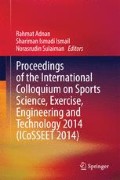Abstract
This paper is focused on the development of wireless measured kinematics specifically for cycling. The aims of this study are to create sensory system with portability, reliability and based on the wireless system. The adjustable crank is novel type of prototype crank that design to maximize the minimum torque at bottom dead center (BDC) and top dead center (TDC) where the crank can be set for ±10° maximum with addition of 5° back and forth from inertial 0° TDC point. The system will measure the power output during cycling to evaluate the cyclist performance. In order to measure power output, the angle displacement (kinematic) and force measurement (kinetic) are needed. The inertial measurement unit (IMU) combination of accelerometers and gyrometers was used to measure the angle and angular velocity of the crank. The system has been validated using a visual system to compare the output provided by IMU. The RMS error value between motion capture camera and IMU for crank angle was 0.480 ± 0.325°. The RMS error value for normalized angular velocity was 0.743 ± 0.911 %. The wireless-based system will aid to reduce the wiring complexity and user-friendly portable measuring system. The wireless communication using Zigbee protocol with two Xbee devices point-to-point will be used to transfer the information to the computer controlled system. The enhancement of this system can be used for coaches for cycling monitoring system to improve cyclist coordination, strategy, and technique.
Access this chapter
Tax calculation will be finalised at checkout
Purchases are for personal use only
References
Coyle, E., Feltner, M. E., Kautz, S., Hamilton, M., Montain, S., Baylor, A., et al. (1991). Physiological and biomechanical factors associated with elite endurance cycling performance. Medicine and Science in Sports and Exercise, 23, 93–107.
Ericson, M. O., Nisell, R., & Németh, G. (1988). Joint motions of the lower limb during ergometer cycling. Journal of Orthopaedic and Sports Physical Therapy, 9, 273–278.
Gregor, R. J., Broker, J. P., & Ryan, M. M. (1991). 4 The biomechanics of cycling. Exercise and Sport Sciences Reviews, 19, 127–170.
Rodríguez-Marroyo, J. A., García-López, J., Chamari, K., Córdova, A., Hue, O., & Villa, J. G. (2009). The rotor pedaling system improves anaerobic but not aerobic cycling performance in professional cyclists. European Journal of Applied Physiology, 106, 87–94.
Jobson, S. A., Hopker, J., Galbraith, A., Coleman, D. A., & Nevill, A. M. (2009). Effect of the rotor crank system on cycling performance. Journal of Sports Science and Medicine, 8, 463.
Lucia, A., Balmer, J., Davison, R., Perez, M., Santalla, A., & Smith, P. (2004). Effects of the rotor pedalling system on the performance of trained cyclists during incremental and constant-load cycle-ergometer tests. International Journal of Sports Medicine, 25, 479–485.
Jobson, S. A., Hopker, J. G., Korff, T., & Passfield, L. (2012). Gross efficiency and cycling performance: A brief review. Journal of Science and Cycling, 1, 3–8.
Bakhshi, S., Mahoor, M. H., & Davidson, B. S. (2011). Development of a body joint angle measurement system using IMU sensors. In Engineering in Medicine and Biology Society, EMBC, 2011 Annual International Conference of the IEEE (pp. 6923–6926).
Boonsawat, V., Ekchamanonta, J., Bumrungkhet, K., & Kittipiyakul, S. (2010). XBee wireless sensor networks for temperature monitoring. In The Second Conference on Application Research and Development (ECTI-CARD 2010). Chon Buri, Thailand.
Faludi, R. (2010). Building wireless sensor networks: With ZigBee, XBee, Arduino, and processing. O’Reilly Media, Inc.
Chen, C., & Pomalaza-Ráez, C. (2009). Monitoring human movements at home using wearable wireless sensors. In Proceedings of the Third International Symposium on Medical Information and Communication Technology.
Bibbo, D. (2007). New techniques for the pedalling performance assessment in cycling.
Fonda, B., & Sarabon, N. (2010). Biomechanics of cycling. Sport Science Review, 19, 187–210.
Kitawaki, T., Tokuyasu, T., & Oka, H. (2011). Evaluation of bicycle pedaling skills using a bicycle crank angular velocity irregularity index (vol. 111, pp. 323–329).
Acknowledgments
This research was performed in biomechanics laboratory and collaboration with Center of Excellence Advanced Sensor and Technology (CEASTech), University Malaysia Perlis.
Author information
Authors and Affiliations
Corresponding author
Editor information
Editors and Affiliations
Rights and permissions
Copyright information
© 2014 Springer Science+Business Media Singapore
About this paper
Cite this paper
Aziz, F. et al. (2014). Adjustable Crank: A Comparison Between Wireless Motion Sensor and Motion Capture Analysis Camera for Crank Kinematic Measurement. In: Adnan, R., Ismail, S., Sulaiman, N. (eds) Proceedings of the International Colloquium on Sports Science, Exercise, Engineering and Technology 2014 (ICoSSEET 2014). Springer, Singapore. https://doi.org/10.1007/978-981-287-107-7_10
Download citation
DOI: https://doi.org/10.1007/978-981-287-107-7_10
Published:
Publisher Name: Springer, Singapore
Print ISBN: 978-981-287-106-0
Online ISBN: 978-981-287-107-7
eBook Packages: EngineeringEngineering (R0)

